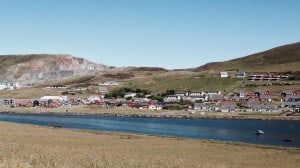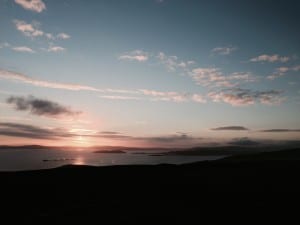 Friday was wet and windy to gale force so we stayed put in harbour, but got thoroughly wet visiting the village. Saturday was a lovely sunny day but with insufficient wind for a long passage, so we waited another day. We had a good lunch in the only hotel and a lovely walk to Noltland Castle and along the coast with amazing white sand and blue seas.
Friday was wet and windy to gale force so we stayed put in harbour, but got thoroughly wet visiting the village. Saturday was a lovely sunny day but with insufficient wind for a long passage, so we waited another day. We had a good lunch in the only hotel and a lovely walk to Noltland Castle and along the coast with amazing white sand and blue seas.
 The feel of the place here is quite different again. It is distinctly nordic – many of the houses are timber-clad and painted in bright colours as in Scandinavia, rather than the greys of Orkney. But then the islands were under Norse rule until 1469, when they were mortgaged to Scotland by the king of Norway as surety against a dowry when his daughter Margaret married James III of Scotland. The mortgage was never redeemed and the islands became Scottish. Back in time the only real trade was with Norway, Denmark, Germany and the Netherlands. The British were not really interested in the isles – at least until oil and gas was discovered. The strong ties with Norway were re-enforced during World War II when the ‘Shetland Bus’ boats shuttled agents, arms and radios to occupied Norway. Even today we have seen only one other British yacht here – most are Norwegian with some Danish and Dutch.
The feel of the place here is quite different again. It is distinctly nordic – many of the houses are timber-clad and painted in bright colours as in Scandinavia, rather than the greys of Orkney. But then the islands were under Norse rule until 1469, when they were mortgaged to Scotland by the king of Norway as surety against a dowry when his daughter Margaret married James III of Scotland. The mortgage was never redeemed and the islands became Scottish. Back in time the only real trade was with Norway, Denmark, Germany and the Netherlands. The British were not really interested in the isles – at least until oil and gas was discovered. The strong ties with Norway were re-enforced during World War II when the ‘Shetland Bus’ boats shuttled agents, arms and radios to occupied Norway. Even today we have seen only one other British yacht here – most are Norwegian with some Danish and Dutch.There is a strong want of independence here – not just from Whitehall but from Scotland. The Scottish Nationalists are not popular. The economic case for an independent Scotland rests heavily on the revenue from Shetland’s remaining oil and gas. Shetlanders feel this should benefit Shetland rather than being used to subsidise the rest of Scotland. The Sheltand flag is the only one flown. It has allusions to Scotland with its colours but features the upright offset cross that occurs in all the Nordic flags. Old traditions last long – the island of Foula in the west is still using the Julian calendar abandoned by the rest of Britain in 1753, so they celebrate Christmas on January 6th and New Year on 13th January.
 We are enjoying the long light evenings at this latitude (over 60°N). The sun does not set until 10:30pm and it is not darkish until midnight and it is light again from 2:00am. So we have had to get used to going to bed while it is still light. However, the winters do not bear thinking about – they say it scarcely gets light and the sun sets at 3:00pm! This photo was taken at 11:00pm while we enjoyed a walk overlooking the dozens of islands off Scalloway with incredible views
We are enjoying the long light evenings at this latitude (over 60°N). The sun does not set until 10:30pm and it is not darkish until midnight and it is light again from 2:00am. So we have had to get used to going to bed while it is still light. However, the winters do not bear thinking about – they say it scarcely gets light and the sun sets at 3:00pm! This photo was taken at 11:00pm while we enjoyed a walk overlooking the dozens of islands off Scalloway with incredible views From here we entered Yell Sound – a vast stretch of water that separates Mainland from Yell. We anchored in Burra Voe for the night. The photo shows a typical habitation hereabout – quite bleak, with maybe a shop if you are fortunate. On Thursday we had a fast sail under just the genoa down the length of Yell Sound with a bumpy exit through overfalls where he water rushing out of the sound hits that flooding up the coast, and then a run all the way to Lerwick.
From here we entered Yell Sound – a vast stretch of water that separates Mainland from Yell. We anchored in Burra Voe for the night. The photo shows a typical habitation hereabout – quite bleak, with maybe a shop if you are fortunate. On Thursday we had a fast sail under just the genoa down the length of Yell Sound with a bumpy exit through overfalls where he water rushing out of the sound hits that flooding up the coast, and then a run all the way to Lerwick.Lerwick is the capital and only town in all Shetland, apart from the small Scalloway. Everything is here if it is anywhere. The town has a long quaint winding paved street with alleyways off, not unlike Stromness.
- The main square
- Commercial Street
- Seagull awaiting breakfast
- Nautical Garage
More news in due course.






Great to hear your news again. I’learning things about that part of Scotland I never knew, thank you.
Much love to you you both from both of us. Alison XX